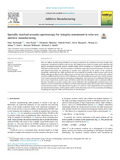JavaScript is disabled for your browser. Some features of this site may not work without it.
| dc.contributor.author | Dryburgh, Paul | |
| dc.contributor.author | Pieris, Don | |
| dc.contributor.author | Martina, Filomeno | |
| dc.contributor.author | Patel, Rikesh | |
| dc.contributor.author | Sharples, Steve | |
| dc.contributor.author | Li, Wenqi | |
| dc.contributor.author | Clare, Adam T. | |
| dc.contributor.author | Williams, Stewart W. | |
| dc.contributor.author | Smith, Richard J. | |
| dc.date.accessioned | 2019-08-14T13:32:28Z | |
| dc.date.available | 2019-08-14T13:32:28Z | |
| dc.date.issued | 2019-05-15 | |
| dc.identifier.citation | Dryburgh P, Pieris D, Martina F, et al., (2019) Spatially resolved acoustic spectroscopy for integrity assessment in wire-arc additive manufacturing. Additive Manufacturing, Volume 28, August 2019, pp. 236-251 | en_UK |
| dc.identifier.issn | 2214-7810 | |
| dc.identifier.uri | https://doi.org/10.1016/j.addma.2019.04.015 | |
| dc.identifier.uri | https://dspace.lib.cranfield.ac.uk/handle/1826/14438 | |
| dc.description.abstract | Wire–arc additive manufacturing (WAAM) is an emergent method for the production and repair of high value components. Introduction of plastic strain by inter-pass rolling has been shown to produce grain refinement and improve mechanical properties, however suitable quality control techniques are required to demonstrate the refinement non-destructively. This work proposes a method for rapid microstructural assessment of Ti–6Al–4V, with limited intervention, by measuring an acoustic wave generated on the surface of the specimens. Specifically, undeformed and rolled specimens have been analysed by spatially resolved acoustic spectroscopy (SRAS), allowing the efficacy of the rolling process to be observed in velocity maps. The work has three primary outcomes (i) differentiation of texture due to rolling force, (ii) understanding the acoustic wave velocity response in the textured material including the underlying crystallography, (iii) extraction of an additional build metric such as layer height from acoustic maps and further useful material information such as minimum stiffness direction. Variations in acoustic response due to grain refinement and crystallographic orientation have been explored. It has been found that the limited α-variants which develop within prior-β grains lead to distinctive acoustic slowness surfaces. This allowed prior-β grains to be resolved. A basic algorithm has been proposed for the automated measurement, which could be used for in-line closed loop control. The practicality and challenges of applying this approach in-line with fabrication are also discussed. | en_UK |
| dc.language.iso | en | en_UK |
| dc.publisher | Elsevier | en_UK |
| dc.rights | Attribution 4.0 International | * |
| dc.rights.uri | http://creativecommons.org/licenses/by/4.0/ | * |
| dc.subject | Additive manufacturing | en_UK |
| dc.subject | Ultrasonic inspection | en_UK |
| dc.subject | Titanium | en_UK |
| dc.subject | Grain refinement | en_UK |
| dc.subject | Crystallographic texture | en_UK |
| dc.title | Spatially resolved acoustic spectroscopy for integrity assessment in wire-arc additive manufacturing | en_UK |
| dc.type | Article | en_UK |
| dc.identifier.cris | 23875654 |
Files in this item
The following license files are associated with this item:
This item appears in the following Collection(s)
-
Staff publications (SATM) [4357]

